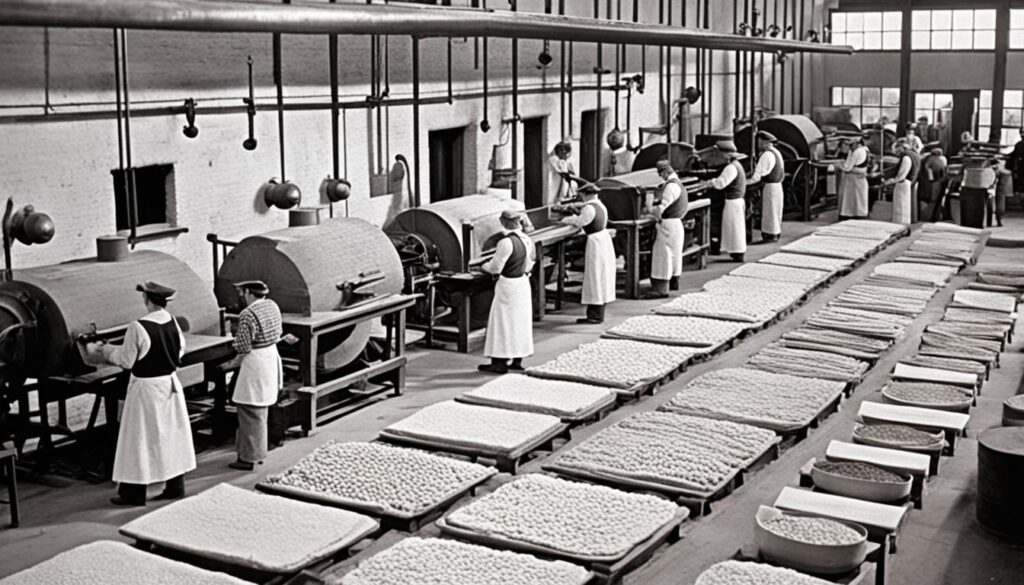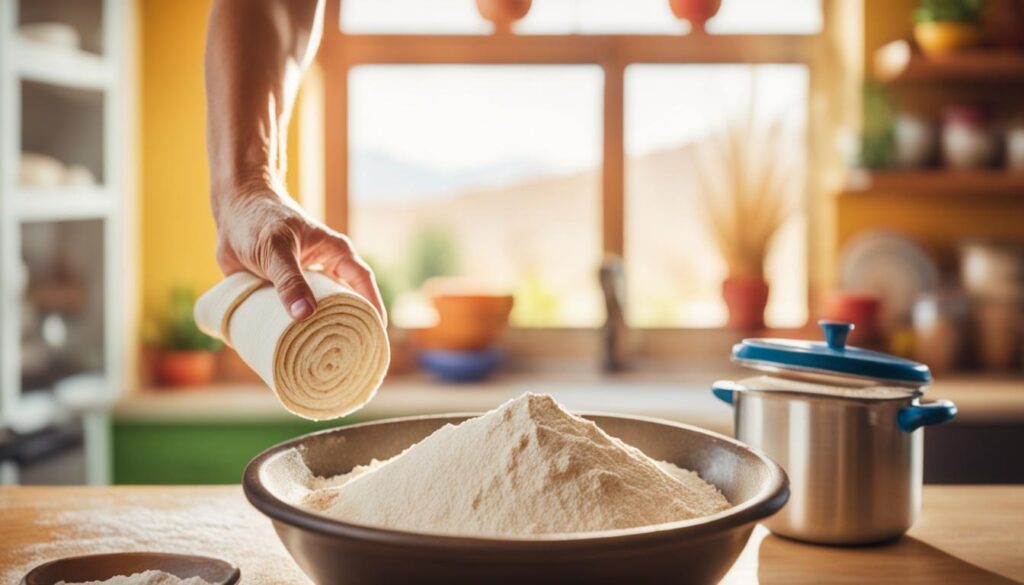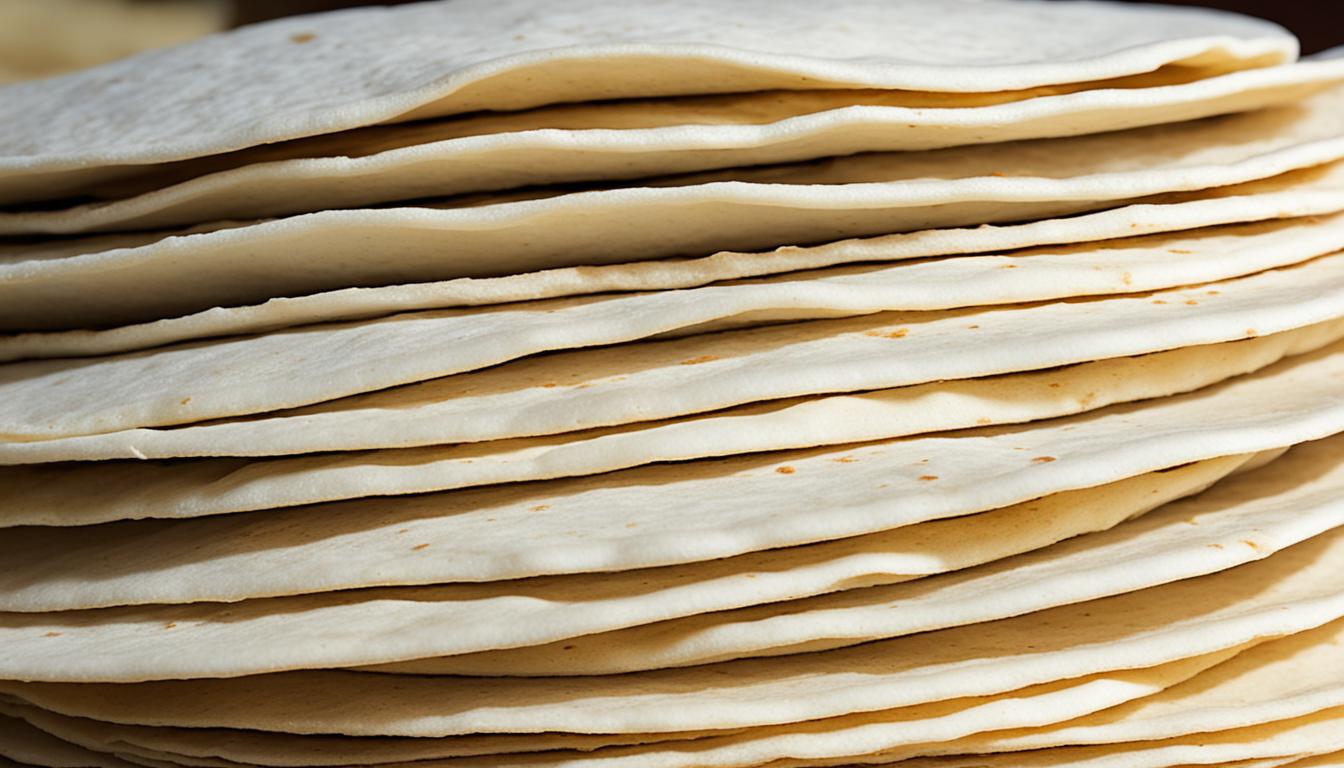Are you craving the authentic flavors of Mexican cuisine? Look no further than the traditional flour tortillas of Northern Mexico. These beloved flatbreads have been a staple in the region for centuries, offering a delicious and versatile canvas for a variety of fillings and dishes. But what makes these flour tortillas from Northern Mexico so special? Let’s dive into their rich history and explore the secrets behind their irresistible taste.
Key Takeaways:
- Flour tortillas are a staple of traditional Northern Mexican food.
- They are made using white Sonoran wheat and have a long history dating back almost 400 years.
- Flour tortillas are best when made fresh daily and can be enjoyed with various fillings.
- They play a crucial role in popular Northern Mexican dishes like fajitas and quesadillas.
- The debate over the choice of fat used in flour tortillas continues, with lard and butter being common options.
Flour Tortilla Varieties in Northern Mexico
In Northern Mexico, flour tortillas come in various sizes and styles. These tortillas, which are thinner and smoother in texture compared to their larger American counterparts, are an essential element of regional Mexican cuisine. The culinary traditions in Northern Mexico emphasize the use of fresh, high-quality ingredients, and the flour tortilla plays a crucial role in enhancing the flavors of popular dishes in this region.
Flour tortillas are used extensively in Northern Mexican cuisine to create a variety of delicious dishes. Some of the most popular applications include:
- Fajitas: Succulent strips of marinated meat, sautéed peppers and onions, and other flavorful ingredients are wrapped in warm flour tortillas to create a mouthwatering fajita feast.
- Enchiladas: Rolled tortillas filled with meat, cheese, or beans, smothered in a rich chili sauce, and topped with cheese, crema, and other garnishes.
- Quesadillas: Oozing with melted cheese, quesadillas are made by folding flour tortillas around various fillings such as meat, vegetables, or even mushrooms, then grilling or frying until golden and crispy.
The versatility, mild flavor, and pliable nature of flour tortillas make them an ideal base for these and other regional Mexican dishes. Whether serving as a vehicle for bold flavors or acting as a canvas for delicate and intricate fillings, the flour tortilla shines in Northern Mexican cuisine.
“The thin and smooth texture of Northern Mexican flour tortillas enhances the flavors of our region’s dishes, making them both satisfying and delicious.”
To give you a visual representation of the different sizes and styles of flour tortillas in Northern Mexico, here is a table showcasing some popular varieties:
| Variety | Description |
|---|---|
| Tortilla de Harina | Large, thin, and slightly elastic tortillas perfect for burritos and chimichangas. |
| Sonora Tortilla | A larger, thin tortilla with a slightly sweet taste commonly used in dishes like carne asada tacos. |
| Machaca Tortilla | A smaller tortilla made from machaca, a seasoned dried beef or pork, often served with scrambled eggs. |
As you can see, flour tortillas come in various shapes and sizes to accommodate the diverse culinary traditions of Northern Mexico. So whether you’re indulging in fajitas, enchiladas, or quesadillas, the flour tortilla is an integral part of the vibrant and flavorful dishes of this region.
The History of Flour Tortillas in Northern Mexico
The history of flour tortillas in Northern Mexico is deeply intertwined with the region’s culinary traditions and the cultural connections between Mexico and the Southwest United States. The story of these versatile and delicious flatbreads dates back to the mid-17th century, with the introduction of white Sonoran wheat by Spanish missionary Padre Lorenzo de Cardenas.
Padre Cardenas brought white Sonoran wheat to the region, and it quickly became a staple crop. The wheat was ground into masa, a dough-like substance used to make tortillas. The process was similar to that of corn tortillas, with the masa being shaped into thin, circular forms.
From their humble beginnings, flour tortillas quickly gained popularity in Northern Mexico and became an essential component of the region’s cuisine. They were enjoyed as a simple accompaniment to meals and as a vehicle for various fillings and toppings.
“The introduction of white Sonoran wheat and its transformation into flour tortillas paved the way for the development of rich culinary traditions in Northern Mexico.”
The popularity of flour tortillas spread beyond Northern Mexico, fueling the growth of the Southwest United States’ Tex-Mex cuisine. Texan flour tortillas, with their distinct texture and flavor, became synonymous with dishes like fajitas, burritos, and tacos.
To this day, flour tortillas remain a beloved and integral part of Northern Mexican and Tex-Mex cuisines. Their versatility allows for a wide range of culinary creations, from simple street tacos to hearty burritos filled with savory meats and beans.

Traditional Homemade Flour Tortillas Recipe
Making traditional homemade flour tortillas is a straightforward process that requires a few basic ingredients. The dough is made from flour, water or milk, fat (such as lard or vegetable shortening), and salt. Some variations may include baking powder for a lighter texture. The dough is kneaded, rested, and then divided into portions that are rolled out into thin circles. The tortillas are cooked on a hot cast iron skillet or comal until they develop golden brown spots. The end result is a soft, delicious, and versatile tortilla that can be enjoyed with a variety of fillings and dishes.
Ingredients
- 2 cups of all-purpose flour
- 1/2 teaspoon of salt
- 1/4 cup of lard or vegetable shortening
- 3/4 cup of warm water or milk
Instructions
- In a mixing bowl, combine the flour and salt.
- Add the lard or vegetable shortening and mix until the mixture resembles coarse crumbs.
- Gradually add the warm water or milk, mixing well until a dough forms.
- Knead the dough on a lightly floured surface for about 5 minutes, until smooth and elastic.
- Shape the dough into a ball and cover with a clean kitchen towel. Let it rest for 30 minutes.
- Divide the dough into small portions and roll each portion into a thin circle.
- Heat a cast iron skillet or comal over medium-high heat.
- Cook each tortilla for about 30 seconds to 1 minute on each side, until golden brown spots appear.
- Transfer the cooked tortillas to a plate and cover with a clean kitchen towel to keep them warm and soft.
Now you have a batch of delicious homemade flour tortillas ready to be enjoyed with your favorite fillings and dishes!
Incorporating traditional homemade flour tortillas into your cooking allows you to honor the rich culinary traditions of Mexican cuisine while adding a personal touch to your meals. Whether you fill them with savory meats and vegetables or use them to make quesadillas or enchiladas, these homemade tortillas will elevate any dish and transport you to the vibrant flavors of regional Mexican cuisine.

The Debate Over Fat in Flour Tortillas
The choice of fat used in flour tortillas is a subject of debate among cooks and culinary traditions. Traditional recipes often call for lard, which adds a distinct flavor and richness to the tortillas. However, some cooks may opt for butter or vegetable shortening as alternatives. The choice of fat can vary depending on personal preference and regional culinary traditions. Both lard and butter can yield delicious results, and the decision ultimately comes down to individual taste and cultural influences.
In authentic Mexican cooking, lard has been a common choice for making flour tortillas. It imparts a unique taste and texture that is deeply rooted in the culinary traditions of Mexico. Lard provides a rich and savory flavor that perfectly complements the fillings and salsas commonly used in Mexican cuisine.
On the other hand, some cooks prefer to use butter for its distinctive flavor and creamy texture. Butter can add a slightly sweet and nutty taste to the tortillas, enhancing the overall dining experience. Additionally, those who follow dietary restrictions or personal preferences may choose to use vegetable shortening instead.
While lard and butter are the most commonly used fats in flour tortillas, there are other options available as well. Vegetable shortening, coconut oil, and even olive oil can be used as substitutes, each imparting a different flavor and texture to the tortillas.
Using the right fat in flour tortillas is essential to achieving the desired taste and texture. Whether you prefer the rich and savory notes of lard or the distinct flavors of butter, the choice of fat plays a crucial role in creating authentic Mexican flavors.
To help you better understand the differences and similarities between lard and butter, we have created a comparison table below:
| Lard | Butter | |
|---|---|---|
| Taste | Rich and savory | Slightly sweet and nutty |
| Texture | Tender and light | Creamy |
| Flavor Enhancement | Enhances the flavors of fillings and salsas | Complements various ingredients |
| Dietary Restrictions | Not suitable for vegetarians or those avoiding animal products | Suitable for vegetarians and those avoiding animal products |
As you can see, both lard and butter have their own unique qualities when used in flour tortillas. Whether you choose one over the other depends on your personal taste preference and dietary needs. Experimenting with different fats can be a fun and delicious way to explore the diverse flavors of authentic Mexican cooking.
Tips for Making Perfect Flour Tortillas
Achieving perfect flour tortillas requires attention to detail and some helpful tips. Here are some key techniques and methods to ensure your homemade tortillas turn out just right:
- Use warm milk or water: When making your tortilla dough, using warm milk or water helps activate the gluten in the flour, making the dough more pliable and easier to work with.
- Roll out the dough evenly: To achieve a consistent texture in your tortillas, it’s important to roll out the dough evenly. Use a rolling pin to create thin, round circles of dough.
- Flipping and lightly flouring: While rolling the dough, make sure to flip it occasionally and lightly flour both sides to prevent it from sticking to the rolling pin or work surface.
- Cook on a well-heated surface: Whether using a hot skillet or a traditional comal, make sure it is well heated before cooking the tortillas. This ensures proper browning and softness.
By following these tips and techniques, along with practice and patience, you can create beautifully crafted homemade flour tortillas that will elevate your meals to the next level.
Flour Tortillas Beyond Northern Mexico
While flour tortillas are synonymous with Northern Mexican cuisine, they have also found a special place in Tex-Mex cuisine. Texan flour tortillas have a distinct texture and flavor profile, with a thick, soft, puffy, and chewy consistency. They are widely used in Tex-Mex dishes such as fajitas, burritos, and tacos. The regional variations in the preparation and characteristics of flour tortillas highlight the diversity and adaptability of this beloved food across different culinary traditions.
Tex-Mex cuisine, a fusion of Mexican and Texan flavors, has gained popularity worldwide for its bold and robust flavors. Flour tortillas play a fundamental role in Tex-Mex cuisine, providing a versatile base for various dishes. The use of Texan flour tortillas elevates the taste and texture of Tex-Mex classics, creating a unique culinary experience.
“Texan flour tortillas have a distinct texture and flavor profile, with a thick, soft, puffy, and chewy consistency.”
The Texan flour tortilla differs from its Northern Mexican counterpart in several aspects. Not only is it thicker and softer, but it also has a slightly sweet flavor. The addition of baking powder or soda to the dough contributes to its puffy and chewy texture. These characteristics make Texan flour tortillas ideal for holding hearty fillings and savoring the rich flavors of Tex-Mex cuisine.
Tex-Mex Flour Tortillas vs. Northern Mexican Flour Tortillas
Let’s compare the key differences between Tex-Mex flour tortillas and Northern Mexican flour tortillas:
| Tex-Mex Flour Tortillas | Northern Mexican Flour Tortillas |
|---|---|
| Thick and soft texture | Thin and smooth texture |
| Puffy and chewy consistency | Flexible and pliable consistency |
| Slightly sweet flavor | Neutral flavor |
| Ideal for holding hearty fillings | Pairs well with a variety of fillings |
Texan flour tortillas are a beloved staple in Tex-Mex restaurants and households, cherished for their unique characteristics that perfectly complement the bold and spicy flavors of the cuisine. Whether used in sizzling fajitas, stuffed burritos, or crispy tacos, Texan flour tortillas add an extra layer of indulgence to Tex-Mex dishes.
Conclusion
Making homemade flour tortillas allows us to experience the authentic taste of Northern Mexico and explore the rich culinary traditions of the region. Whether we choose to use lard, butter, or another fat option, the process of making these tortillas is relatively simple, and the results are incredibly satisfying.
The ability to customize the size, thickness, and flavor of our tortillas opens up a world of culinary possibilities, allowing us to create delicious dishes that showcase the versatility of this traditional flatbread. Whether we’re enjoying them as part of a breakfast burrito, a lunchtime quesadilla, or a dinner feast of fajitas, homemade tortillas add that special touch of authenticity to our meals.
So, let’s roll up our sleeves, gather our ingredients, and embark on a flavorful journey by making our own homemade flour tortillas. The satisfaction of crafting these beloved Mexican staples from scratch is sure to delight our taste buds and impress our friends and family!
